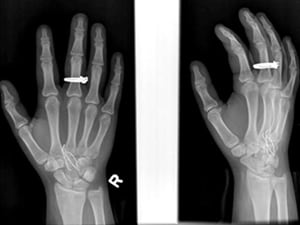May 10, 2011 — Self-embedding behavior (SEB) in adolescents is a type of severe self-injury presenting a new primary care challenge, according to the results of a retrospective study reported online May 9 and in the June print issue of Pediatrics.
"[SEB] is an extreme form of self-injury involving the insertion of inanimate objects into the soft-tissues, either under the skin or into muscle," write Gregory H. Bennett, BS, from the Department of Radiology, Nationwide Children's Hospital, and the Ohio State University College of Medicine and Public Health in Columbus, and colleagues.
 |
Metal staples are shown on the X-ray of a teenage girl. Courtesy RSNA.
|
"To date, no case series data on this behavior among adolescents has been described in the pediatric medical literature.... The goal of this study was to define [SEB], develop a clinical profile of adolescents who engage in SEB, and emphasize the importance of rapid, targeted, and effective identification and intervention."
Using a database assessing 600 patients who were percutaneously treated for soft-tissue foreign body removal, the investigators identified adolescents with foreign bodies self-embedded in the soft tissue and described their demographics, psychiatric diagnoses, and characteristics of SEB.
Three patients did not report a purpose for SEB, but 6 (75%) of 8 patients who reported this information stated that it was related to suicidal ideation. The foreign bodies were typically made of metal and embedded in the arm, with a mean of 2.4 objects embedded in a single episode. Using ultrasound or fluoroscopic guidance, 76 foreign bodies were percutaneously removed; these included metal, glass, wood, plastic, graphite, and crayon.
"SEB is an extreme form of self-injury requiring aggressive and timely interdisciplinary assessment and treatment," the study authors write. "An understanding of SEB allows medical professionals to pursue rapid, targeted, and effective intervention to interrupt the cycle of self-harm and institute appropriate long-term therapy."
Limitations of this study include small sample size, a homogeneous sample obtained from a single source, and use of retrospective data obtained from medical records. Although all of the identified patients were diagnosed with bipolar disorder, the clinical chart did not include data regarding whether SEB occurred during a manic episode.
"Despite limitations, our results suggest a few factors medical professionals need to be aware of regarding the presence of adolescent SEB; learn how to screen for, assess, and distinguish SEB from other forms of self-injury (including risk for suicidality versus nonsuicidality), and make timely and appropriate mental health and radiologic referrals," the study authors conclude. "In addition, these mental health professionals need to work with their patients to find alternative, safer and healthier coping strategies to SEB to meet the same function. They must also assess and treat the high degree of comorbidity associated with SEB."
The study authors have disclosed no relevant financial relationships.
Medscape Medical News © 2011 WebMD, LLC
No comments:
Post a Comment